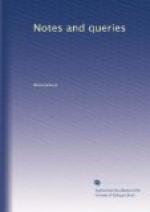“David Betonius, S.R.E.,
Card. Archiep. S. Andreae in Scotia, ab
Hostibus Fidei Barbare Trucidatus.”
Beaton was elected to the Cardinalate in Dec. 1538; did he visit Rome after that? He was at all events in Paris. The Scotch College at Rome was a natural habitat for a portrait of a Scottish churchman so famous as Cardinal Beaton, and it would be strange indeed if they had not one of him where they affected a collecion of portraits of British prelates. I propose to have this portrait engraved, if its probable authenticity cannot be shaken. Did Pinkerton engrave any portrait of Beaton? There is none in my copies of his Iconographia Scotica, 1797, and his Scottish Gallery, 1799. These contain several duplicates; but it is rare to meet with copies that can be warranted perfect. If the portrait be published, it will probably be accompanied by a short memoir, correcting from authentic documents some of the statements of his biographers: any information either as to the portrait or his life will be thankfully acknowledged. One or two letters from Lord Buchan, on the subject of Scottish Portraits, appeared in the Gentleman’s Magazine, vol. lxv., but not relating to this particular one.
Scotus.
* * * * *
On the pointing of A passage in “All’s well that Ends well.”
Lafeu. “They
say miracles are past: and we have our philosophical
persons, to make modern and
familiar, things, supernatural and
causeless.”—Act
ii. Scene 3.
So the passage is pointed in Johnson and Steevens, that is, with a comma after the word “things;” and the same pointing is used in the recent editions of Mr. Knight, Barry Cornwall, and Mr. Collier.
It occurred to me that this pointing gave a meaning quite out of harmony with what directly follows, and also with the spirit in which Lafeu speaks. Let the comma be placed after “familiar”, and the whole passage be read thus:




